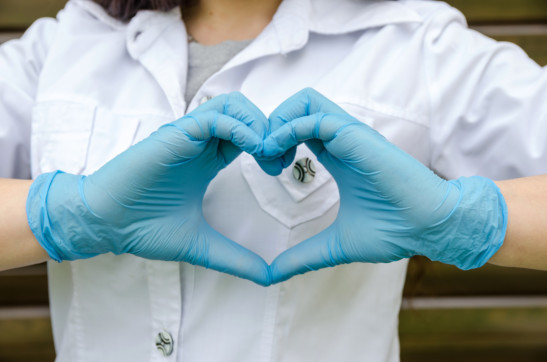Taking Doctors’ Day Beyond the Direct Mail Appeal

If you’re going to try something new, now is the time!
Last year you likely had to shake up your events strategy, find new ways to communicate with all types of donors, and might even have found that virtual donor visits can be just as effective as in-person (and perhaps even appreciated when we’re all locked down).
Is it time to rethink Doctors’ Day, which occurs annually on March 30th?
Download our Doctors’ Day Toolkit for tons of ideas, tips and tricks.
Most Doctors’ Day marketing efforts involve direct mail appeals, and we are not suggesting that you get rid of those traditional efforts if they have been successful for you. However, we are suggesting that you consider ways to reach people who you don’t reach with direct mail, as well as to take advantage of the shift to digital channels that has been accelerated over the past 12 months.
Regardless of what your goals are for the campaign – fundraising, engagement, acquisition, or just building a culture of gratitude – here is a framework you can use to take your campaign to the next level and take advantage of the flexibility that an integrated digital engagement approach can provide.
Start by Creating Awareness (Especially for New or Lapsed Supporters)
When you move beyond a direct mail appeal, you can reach more people, especially younger and more technically-savvy demographics who might not even open a physical mailing.
Doctors’ Day campaigns are built on a “foundation” of gratitude. But, not all of your audience has the same relationship with your organization – or are even aware of the role philanthropy plays in the availability and quality of care in their community.
With that in mind, consider planning your Doctors’ Day campaign around different audience segments, with different messages and “calls to action” for each group. For instance, when communicating with “cold prospects” or lapsed supporters (what we often call our LYBUNTS and SYBUNTS), start with an awareness or engagement component to ensure your recipients understand the need and opportunity for getting involved
Start with a “soft ask,” rather than a direct ask. If you know you are emailing a patient, ask them to write a thank you note. If you aren’t sure the person is a patient, maybe you ask them to share a community health-related post on social media. When engaging existing donors, make sure to acknowledge their previous contributions and the importance of their relationship.
The immediate goal of this type of communication is not a gift, but rather stimulating interest and growing the engagement of your recipients. In face-to-face fundraising we, of course, know that a donor needs to understand what they are giving to and why before they even consider making a gift, but this is often lost in direct response campaign planning.
Ensure your communications provide an opportunity for people to engage with your organization and get involved in an important initiative that involves much more than just a transaction. Maybe you ask them to share their story about how a physician made a difference, send an ecard to their doctor, or sign a virtual thank you note that displays on your website. These are all simple calls to action that encourage recipients to get involved. Or maybe you want them to watch a video, join your ambassador program, or make a small ask, like “chip in for lunch.”
When a supporter takes one of these actions, you are both raising awareness for your organization, as well as learning which recipients are willing to engage, and who is grateful. Not everyone who feels grateful will give but giving is predicated on gratitude.
Growing Involvement and Gratitude for Engaged Supporters
Engagement campaigns such as Doctors’ Day use a low touch, high volume approach. Naturally, using digital tools to power this type of campaign offers a lot of advantages. Costs per message are low and you receive feedback on each communication and the interests of your recipients in real-time, allowing you to improve subsequent messages in the campaign. Today’s donors expect to have conversations online, and now more than ever they’re used to giving online.
According to Blackbaud Institute Index, across all nonprofit subsectors, there has been a 36% increase in online giving year-over-year from April through June 2020 compared to the same time period in 2019. And in the past 12 months ending in September 2020, the healthcare subsector experienced a 0.5% decrease in overall giving and a 6.2% increase in online giving.
When you sit down to plan your campaign, keep in mind your goals and think about the different calls-to-action that will motivate different types of supporters. As mentioned above, we recommend keeping your campaign focused on gratitude – asking people to say thank you, sharing messages of thanks, asking friends to participate, etc. Gratitude will naturally lead to engagement and, for a mass marketing campaign, that engagement leads to or even becomes the actual fundraising ask.
4 Ways to Use Online Fundraising to Encourage Gratitude on Doctors’ Day
- Send a virtual thank you card
Use a simple online form through your donor management software to invite the community to thank physicians. With pre-populated designs, you just need to collect some basic information (including email address) from the sender. Then, print out the cards and hand deliver to the doctor. Think how much she will enjoy that unexpected bit of gratitude!
Plus, this is a great acquisition strategy for you! As part of the online form, ask if the foundation can get in touch (grow your email list!). And on the confirmation page, include a soft ask with an online donation form. You might be surprised to see how many people choose to give when they take a moment to experience gratitude – even without a direct ask from your organization.
- Create a virtual thank you “wall”
One of the tremendous advantages of digital campaigns is that you can offer multiple calls to action across multiple messages in a campaign series. If recipients don’t respond to your request to complete a virtual thank you card (or if that isn’t right for your organization), consider a follow-up message asking them to sign a tribute wall. This still encourages gratitude, reminds donors they are valued, and identifies grateful patients/families. Names on the thank you “wall” can be printed and displayed or rendered virtually online. Similar to a card, you can also require basic contact information and include a soft ask on the confirmation page. If you have ambassadors, having them say thank you online to everyone who participates is a great way to further that culture of gratitude.
- Get your friends involved
People are more likely to give to someone they know than they are to give to a hospital foundation. Imagine the impact of a friend saying, “help me thank the doctor that saved my life.” By setting up a simple online fundraising page, this person can collect donations and words of thanks for the physician. To identify potential DIY fundraisers, you can start with past donors who have expressed gratitude toward a physician. You can also use analytics to determine the people in your database who are most likely to fundraise on your behalf.
This is both a high-yield fundraising strategy as well as a great acquisition channel for new donors who might want to get involved further. In fact, the value of this type of peer-to-peer fundraising often comes from the long-term value of these new supporters rather than their one-time contributions.
- Make it an online competition
Bring in your corporate sponsors, the local television stations, or even geographic regions to compete against each other. Use an online peer-to-peer fundraising page to easily track donations. Even though donors are making a gift to help their group win, they might still share their story of gratitude.
Many healthcare organizations have a Guardian Angel-type program where physicians are honored when a gift is made on their behalf. Use a peer-to-peer fundraising page to take this concept online and make it accessible to a wider audience.
Make it Easy to Play a Role in Doctors’ Day Success
You don’t need to offer all of these engagement ideas, but you will likely have the best outcomes when you match a single, specific, and purposeful call to action for each type of relationship amongst your supporters. We suspect this will offer a better response than a menu of options for getting involved and giving back.
Keep in mind, supporters (especially new or lapsed) are only going to participate if you make it easy. Be very clear about what you want them to do and why, and what it means to your organization and your physicians.
Finally, don’t forget to respond in turn with a thank you and impact messaging about YOUR gratitude for their role in making your Doctors’ Day a success. Schedule appropriate stewardship messages as a follow up to encourage longer-term engagement over time.
Our world has changed forever over the past 12 months, and NOW is the time to try something new! And now more than ever, doctors (and donors) need to feel the love.
 Free Resource
Free Resource

